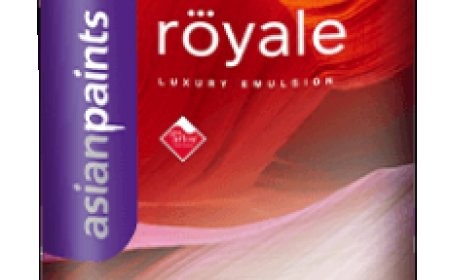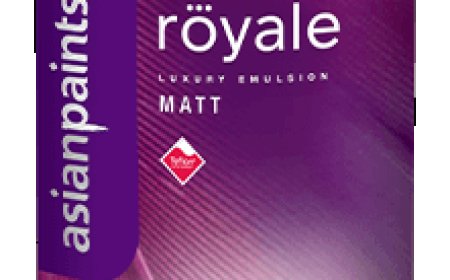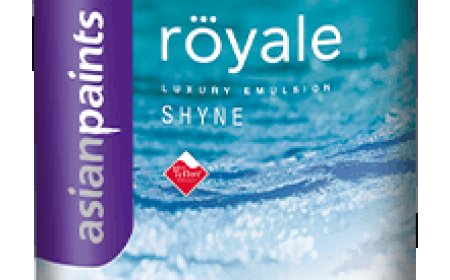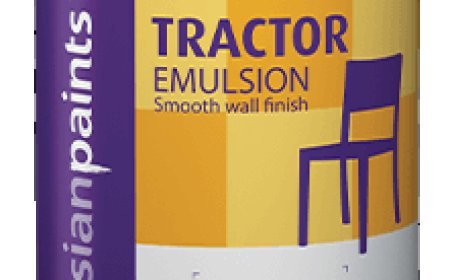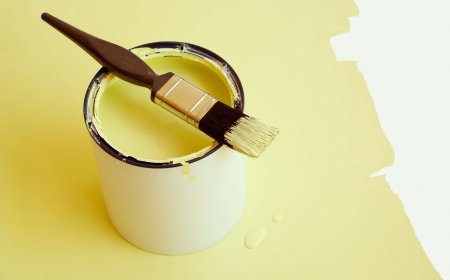Different Types of Interior Paints
Different types of Interior Paints. A beautiful and comfortable living space is mostly dependent on the interior paint color selection. The color and quality of your paint can significantly affect the entire look and feel of a room, impacting everything from mood to perceived size. High-quality interior paint not only adds beauty to your walls but also makes them easy to maintain and durable. It makes your walls resistant to normal wear and tear and easy to clean. Choosing the right interior paint establishes the foundation for a place you'll love to live in, whether your goal is to maintain the surfaces of your home or update its style.
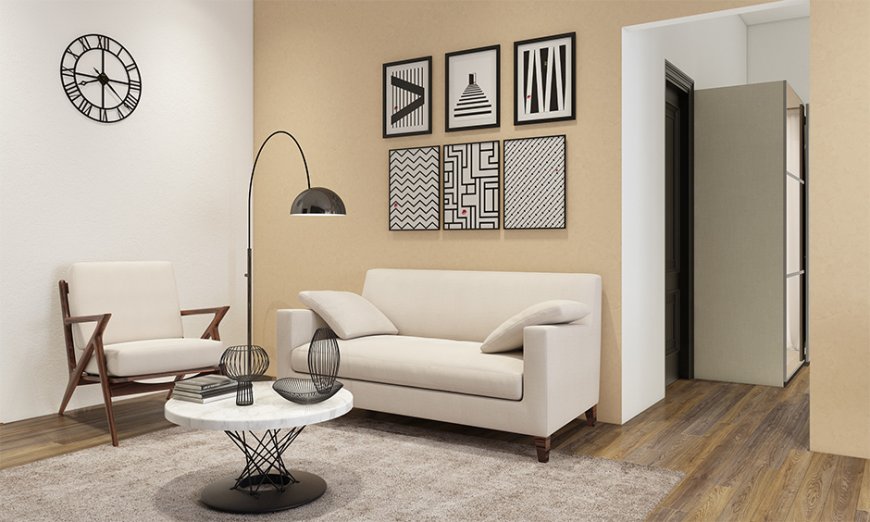
Different types of Interior Paints
Introduction
A beautiful and comfortable living space is mostly dependent on the interior paint color selection. The color and quality of your paint can significantly affect the entire look and feel of a room, impacting everything from mood to perceived size. High-quality interior paint not only adds beauty to your walls but also makes them easy to maintain and durable. It makes your walls resistant to normal wear and tear and easy to clean. Choosing the right interior paint establishes the foundation for a place you'll love to live in, whether your goal is to maintain the surfaces of your home or update its style.
There are various paint kinds available, each with special qualities and advantages, for interior painting. Acryl paint, sometimes referred to as latex paint, dries fast and is water-based, making cleanup with soap and water simple. It is also a well-liked option for indoor use due to its minimal odor. If high-traffic areas like kitchens and bathrooms are interested, oil-based paint offers a long-lasting surface that is a waterproof to damage. There are also specialty paints available, like stain-blocking paint that helps cover up stains and color changes that are difficult to remove and primer paint that offers a smooth surface for painting.
Understanding Interior Paint Finishes
Understanding paint finishes is critical when selecting the appropriate paint for your interior walls. Flat paint has a matte texture and is effective at masking weaknesses but it is not as durable or washable as other finishes. Eggshell paint has a weak gloss and is more durable, so it's ideal for low-traffic spaces like bedrooms and living rooms. Satin paint is a popular option for bathrooms and kitchens because of its easy-to-clean nature and smooth, silky surface. Semi-gloss paint is great for reduce, doors, and high-traffic areas since it has a glossy surface, is extremely washable, and is quite durable. Shine and durability are the greatest qualities of gloss paint, but defects are more noticeable. Think on the degree of shine and durability.
Understanding the features and recommended applications for each paint finish is critical for getting the ideal look and durability in your area. For low-traffic areas like ceilings and bedrooms, flat paint works well because it hides defects and provides a smooth, matte texture. It's perfect for living rooms and dining rooms since eggshell paint has an air of gloss and is more durable. A great option for kitchens and bathrooms, satin paint has a velvety, smooth surface and is very easy to clean. Perfect for trim, doors, and high-traffic areas, semi-gloss paint has a glossy finish and is extremely washable and durable.
Latex Paints
Acrylic paint, sometimes referred to as latex paint, is a common paint type for both indoor and outdoor surfaces. It is created using a water-based mixture that includes additives, colors, and acrylic polymers. The paint is simple to apply and wash with soap and water since the water serves as a carrier for the other chemicals. Latex paint dries rapidly, produces little odor, and is resistant to fading, cracking, and yellowing over time. It is suitable for a variety of painting applications because it comes in a broad range of colors and finishes. All things considered, latex paint is a practical and long-lasting choice for both homeowners and do-it-yourself users.
Latex paint has both advantages and disadvantages as well. Because of its water-based formula's simplicity of use and cleanup, this is one of its key benefits. Latex paint also dries quickly, allowing for shorter painting projects. Additionally, it has a reduced odor than oil-based paints, making it a better choice to work with. The drawback of latex paint is that it might not last as long as oil-based paints, particularly in places with heavy usage. It may also struggle to attach to certain surfaces if not properly prepared. All things considered, latex paint is a widely used option for numerous painting tasks because of its flexibility and simplicity of use.
There are numerous uses and surfaces for latex paint. It is great for external siding, decks, and fences, as well as interior walls, ceilings, and decor. It's adaptable for a variety of home improvement projects because it works on wood, metal, drywall, plaster, and stone surfaces. Applying and cleaning up latex paint is a breeze, making it an excellent option for novices and do-it-yourselfers alike. To guarantee successful follow-up and the longevity of the paint job, it is crucial to carefully prepare the surface before painting. All things considered, latex paint is a flexible choice for a variety of painting tasks, both indoor and outdoor.
Oil-Based Paints
Oil-based paint is manufactured by combining pigment particles, oils, solvents, and additives. While oils like seed oil or alkyd resin function as binders to keep the pigment together and offer bonding to surfaces, the pigment particles give color. When applying paint, solvents such as alcohol or mineral spirits are used to thin the paint, which then goes when the paint dries. To improve qualities like flow, durability, and drying time, additives may be used. Paint with an oil base is renowned for its longevity, resilience to decline and capacity to produce a glossy, smooth surface. However, it has a strong smell, takes longer to dry, and requires harsh chemicals for cleanup.
When it comes to oil-based paint, there are benefits and negatives to consider. Its longevity and capacity to provide a long-lasting, glossy surface are among its primary benefits. Oil-based paint is perfect for high-traffic surfaces like doors, trim, and cabinets since it is also very resilient to damage. On the other hand, oil-based paint requires more time for healing than water-based paint and smells much stronger. Additionally, cleaning up after it calls for strong solvents like mineral spirits, which can be dangerous and difficult. Additionally, oil-based paint eventually turns yellow, especially in places that are exposed to the sun. For some applications where power and quality are important considerations, oil-based paint is always a popular option in spite of these disadvantages.
If a smooth finish and durability are important to you, oil-based paint is suggested for specific surfaces and applications. Wood, metal, and previously painted surfaces that require a durable layer are among the materials it works well on. Siding and trim for exterior surfaces are among the common applications, along with doors, trim, cabinets, and furnishings. Oil-based paint has outstanding durability and attachment, which makes it suitable for areas that see a lot of wear and usage. That might not be the best choice for all indoor jobs or locations where speedy turnaround and minimal odor are essential, though, because of its extended drying time and stronger smell.
Acrylic Paints
The water-based nature of acrylic paint makes it a popular and flexible paint type. The paint has a low smell, dries rapidly, and is easily cleaned with water thanks to the suspended form of pigments in an acrylic polymer emulsion. Artists and crafters love acrylic paint because it sticks nicely to a variety of surfaces, such as canvas, paper, wood, and cloth. You can express your creativity and customize it with the variety of colors and finishes it comes in. It's well known that acrylic paint is flexible, long-lasting, and has the ability of producing packed textures as well as thin washes. It works for a range of creative interests and do-it-yourself tasks due to its overall user-friendly character.
Acrylic paint is highly valued for its durability and versatility in creative and do-it-yourself activities. It is appropriate for many different uses because it sticks effectively to a variety of materials, such as canvas, paper, wood, and fabric. Acrylic paint provides long-lasting results whether you're painting a masterpiece on canvas or refinishing furniture. Because of its versatility, it may be used for a variety of artistic styles and techniques, allowing sensitive washes, rich textures, and effortless mixing. Acryl paint also has an excellent track record for not chipping, fading, or yellowing over time, so your masterpieces will last a lifetime. Acrylic paint is generally a preferred option for painters, skilled workers, and do-it-yourself lovers due to its strength and elasticity.
Acrylic paint is suitable for a wide range of surfaces and applications due to its versatility and durability. There are countless creative possibilities with it because it works well on materials including canvas, paper, wood, fabric, ceramics, and even glass. Acrylic paint is used by artists for painting, sketching, mixed media, and other applications because of its ability to create both thin washes and rich textures. Acrylic paint is also popular among DIY fans for tasks such as home decor, furniture painting, and crafting, as it produces brilliant colors and long-lasting results. Acrylic paint is a flexible and dependable option for realizing your artistic ambitions, regardless of your level of experience as a crafter.
Milk Paints
Milk paint boasts unique characteristics and an appealing aesthetic that sets it apart from other types of paint. Its natural composition gives it a distinctive matte finish with subtle variations in color, adding depth and character to painted surfaces. One of its standout features is its ability to create a soft, aged look reminiscent of antique furniture and historical buildings. Milk paint also has a charming, chalky texture that adds tactile interest to surfaces. Its eco-friendly and non-toxic properties make it a popular choice for those seeking environmentally conscious options. Overall, milk paint's distinct qualities and timeless appeal make it a favorite for artisans, decorators, and DIY enthusiasts alike.
Milk paint has unique and a beautiful look that defines it from other forms of paint. The unique matte texture and minor color variations created by its natural composition offer painted surfaces an air of depth and personality. Making a smooth, aged look characteristic of old furniture and historic buildings is one of its best qualities. Milk paint also provides a nice, powdery feel that provides physical interest to surfaces. People looking for environmentally friendly solutions frequently choose it because of its non-toxic and eco-friendly qualities. All things considered, DIY fans, decorators, and artists alike love milk paint for its unique features and classic charm.
Wood, plaster, drywall, metal, and even masonry can all be painted over with milk paint due to its flexibility. It works great to add a vintage or damaged effect to walls, cabinets, and furniture since it sticks well to open surfaces. Because of its unique feel and finish, it's also frequently used for crafts, decorative painting, and art projects. Milk paint is also an excellent choice for historical restoration jobs, as it matches the true look of previous finishes. Milk paint allows you to express your creativity in countless ways, whether you're refinishing furniture or adding character to your interior design.
Chalk Paints
The matte, chalky looks and ease of application of chalk paint make it a popular paint variety. A special combination of talcum powder, pigment, water-based binders, and calcium carbonate is used to make it. It is ideal for do-it-yourself projects and furniture makeovers because of one of its unique qualities: it can stick to practically any surface without priming or sanding. Chalk paint dries quickly, allowing for numerous applications in a short period of time, and it can be vanished or antiqued for a look that is older. It is a popular option for indoor projects due to its non-toxic composition and minimal smell, and it comes in a variety of colors to match any decor or taste.
Chalk paint produces a unique distressed looks that adds character and charm to furniture and decor. Using chalk paint, you may easily get a faded, old look by sanding lightly or revealing layers of paint beneath with a sanding block. You may give your objects a lovely, weathered look with this approach, giving them more depth and beauty. Chalk paint also works well for stenciling, layering colors, and producing textured effects, among other decorative uses. Chalk paint offers several creative alternatives for obtaining a damaged looks while improving your home decor.
Chalk paint is ideal for crafts, décor projects, and furniture makeovers since it is so flexible and can be applied to a wide range of surfaces, including wood, metal, plastic, and even cloth. You can save time and effort by using its special structure on most surfaces, as it attaches well without requiring priming or sanding. You may use chalk paint in a variety of ways to get different effects, such troubling, layering colors, or providing textured finishes. Chalk paint is a creative and flexible medium that can be used for an infinite number of projects, from personalizing home décor to restoring outdated furniture.
Specialty Paints
A unique and creative approach to add touches of character to your living area is using specialty interior paints. Making any surface into a magnetic board using magnetic paint is a great way to organize notes or show off artwork. Paint with texture gives walls more body and depth, drawing attention to details while hiding problems. Paint that glows in the dark gives ceilings and other accent pieces a magical look and a gentle glow at night. Customizing your home's decor and adding unique touches that express your individuality and style is made possible by these specialty paints.
Specialty interior paints have unique features that set them apart in home decorating tasks. For example, surfaces can be made interactive with magnetic paint, making them ideal for home offices or children's rooms. If you want to add visual interest or create focal areas, textured paint is a great way to give your walls depth and character. Paint that glows in the dark gives ceilings and accent pieces a magical touch, giving bedrooms and playrooms a magical atmosphere. These specialty paints are a favorite among designers and do-it-yourself lovers because they provide countless opportunities for artistic expression and may turn plain rooms into beautiful ones.
Low VOC and Zero VOC Paints
Chemicals that readily evaporate into the air are known as volatile organic compounds, or VOCs. Paints, varnishes, and cleaning supplies are just a few of the household products that usually use them. VOCs can negatively impact human health and indoor air quality, which can lead to problems like headaches, vertigo, and difficulty breathing. VOCs are frequently employed as solvents in paint to maintain the paint's liquid state and promote drying. Air pollution within buildings can result from their discharge of toxic gases into the atmosphere both during and after painting. Low-VOC or VOC-free paints are better for households and the environment since they can help limit contact with dangerous chemicals and improve indoor air quality.
The environment and human health can benefit from low- and zero-VOC paints in a number of ways. First off, by lowering the amount of dangerous chemicals released into the air during and after painting, they contribute to better indoor air quality and help relieve headaches and breathing issues. Low and zero VOC paints are also better for people who are sensitive to chemicals or have reactions. Additionally, by lowering outdoor air pollution and dangerous ozone formation, they help create a healthier atmosphere. Additionally, buyers who care about the environment will find low and zero VOC paints to be superior options because they promote eco-friendly living and sustainable practices. All things considered, choosing low- or no-VOC paints promote sustainability and environmental responsibility while offering a safer and healthier painting experience.
When it comes to painting, considering both health and environmental factors is essential. Traditional paints often contain harmful chemicals called volatile organic compounds (VOCs) that can contribute to indoor air pollution and negatively impact health. Opting for low or zero VOC paints can significantly reduce exposure to these harmful chemicals, promoting better indoor air quality and reducing the risk of respiratory issues or allergies. Additionally, choosing paints that are eco-friendly and sustainably produced can help minimize environmental impact by reducing pollution and conserving natural resources. By prioritizing health and environmental considerations when selecting paints, you can create a safer and more sustainable living environment for yourself and future generations.
Choosing the Right Paint for Your Project
To achieve the finest results, many factors must be addressed while selecting interior paint. Prior to painting a room, consider its purpose. Paint that is both long-lasting and easily cleaned is essential for high-traffic areas such as bathrooms and kitchens. You should also think about the kind of surface you want to paint on, like metal, wood, or drywall, as different paints have varied bonding properties to different materials. Selecting a paint color should also take into consideration the type of finish you wish to achieve, such as glossy, satin, or matte. You may choose the ideal interior paint for your project and easily produce the desired outcomes by taking these elements into account.
Making an informed decision when selecting interior paint is crucial for achieving the best results. Start by researching different paint brands and their product lines to find options that meet your needs in terms of durability, color selection, and eco-friendliness. Consider seeking recommendations from friends, family, or online reviews to get insights into others' experiences with specific paints. Additionally, take advantage of paint samples to test colors and finishes in your space before committing to a large quantity. Don't forget to consider factors like room lighting and existing decor when making your decision. By taking these steps, you can confidently choose the right interior paint for your project and ensure a successful outcome.
What's Your Reaction?







